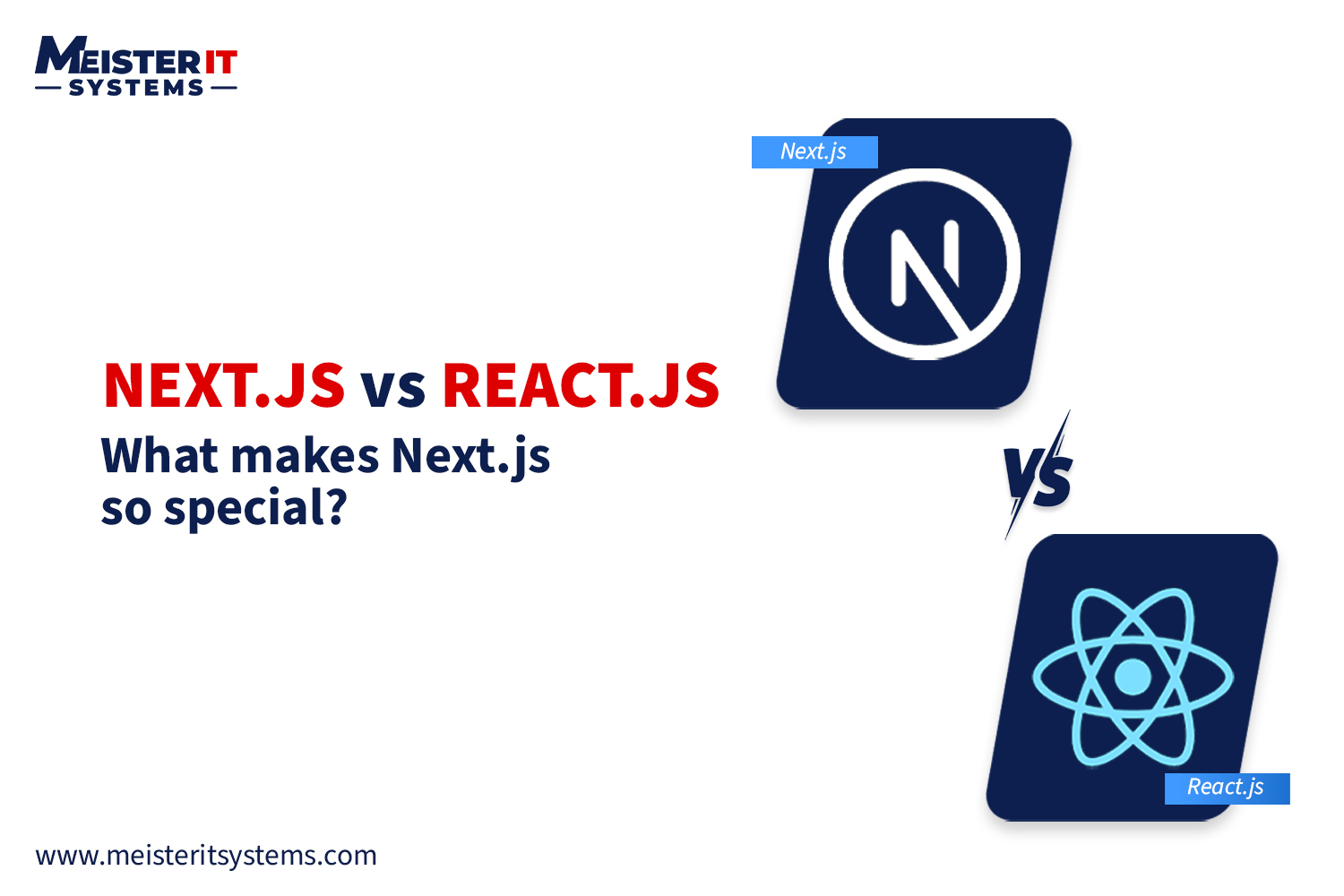Introduction
Next.js has rapidly gained traction, now powering 1.9% of JavaScript-based websites—more than doubling its share since 2022. This surge reflects a growing need for web frameworks that offer speed, scalability, and SEO-friendly features.
While React.js remains a favorite for building dynamic web applications, developers increasingly turn to Next.js for its built-in optimizations and seamless development experience.
But what exactly sets Next.js apart? How does it compare to React.js, and which is the right fit for your project? Let’s break down their key differences to help you decide.
Next.js vs React.js: Key Differences
Here are the key differences between Next.js and React.js.
| Feature | React.js | Next.js |
|---|---|---|
| Rendering | Client-Side Rendering (CSR) | Supports SSR, SSG, ISR, and CSR |
| SEO Optimization | Requires additional configurations | Built-in SEO-friendly features, including pre-rendering and fast load times |
| Routing | Uses React Router | File-based routing for simplified navigation |
| Performance | Depends on CSR | Faster with SSR and SSG, improving Core Web Vitals |
| Code Splitting | Manual | Automatic, reducing initial load time |
| API Handling | Requires backend integration | Built-in API routes for full-stack capabilities |
| Static Site Support | Not natively supported | Supports static site generation for improved SEO |
| Image Optimization | Needs third-party libraries | Built-in image optimization for better performance |
| Development Speed | Requires additional setup | More features available out-of-the-box, reducing setup time |
| TypeScript Integration | Requires manual setup | Native TypeScript support |
| Scalability | Suitable for SPAs | Ideal for large-scale applications with hybrid rendering |
| Middleware Support | Not included | Built-in middleware support for better control over requests |
Next.js outshines React.js in SEO, performance, and scalability, while React.js remains a flexible choice for SPAs needing client-side interactivity.
Why Choose Next.js Over React.js?
Next.js builds on React by offering better SEO, faster performance, and enhanced scalability, making it the go-to framework for modern web development.
Here’s why it stands out:
1. Better SEO and Search Rankings
Next.js enhances SEO by pre-rendering pages, making it easier for search engines to index them. React, on the other hand, requires additional tools like React Helmet to optimize SEO.
2. Faster Website Performance
Next.js makes websites load faster by using static site generation (SSG) and automatic code splitting. This reduces the size of JavaScript bundles and improves website speed, which is important for ranking well on Google.
3. Scalability and Flexibility for Enterprise Applications
With multiple rendering strategies (SSR, SSG, ISR, and CSR), Next.js offers unparalleled flexibility, making it ideal for small-scale websites and large enterprise applications alike.
4. Improved User Experience and Engagement
With built-in image optimization, lazy loading, and faster page loads, Next.js ensures a smoother and more responsive UI, leading to lower bounce rates and better user retention.
5. Simplified Backend Integration for Full-Stack Development
API routes in Next.js allow developers to create and manage backend functionalities without needing a separate backend framework, making it ideal for full-stack web development.
6. Optimized Development & Security
Next.js offers a superior developer experience with features like hot reloading, automatic TypeScript support, and a simplified deployment process through Vercel. Next.js provides better security than React alone by reducing exposure to client-side vulnerabilities through server-side rendering and API route handling.
7. Built-in Internationalization for Global Reach
Next.js makes it easier to build multilingual applications with built-in i18n support, reducing reliance on external libraries and ensuring a seamless experience for international users.
When to Use React.js Instead of Next.js?
While Next.js offers many advantages, React.js might still be the better choice in certain scenarios:
- If you’re building a simple, client-side application without SEO concerns.
- If your project requires heavy client-side interactivity that doesn’t benefit from SSR or SSG.
- If you need full control over routing and don’t want a file-based system.
- If your team is already experienced with React and prefers minimal learning curve additions.
- If you're building a small project that doesn’t require advanced optimizations or performance enhancements.
- If you want complete flexibility in choosing third-party tools for routing, state management, or data fetching.
Real-World Use Cases of Next.js
Tech giants and startups widely use Next.js for its performance, scalability, and SEO benefits. Here are some well-known companies using Next.js:
- Netflix: Uses Next.js for its front-end architecture to improve performance and search rankings.
- Twitch: Optimizes the gaming streaming experience with Next.js, ensuring faster page loads.
- Hulu: Uses Next.js for fast-loading and SEO-friendly pages, improving content discoverability.
- Nike: Enhances online shopping experience with optimized performance and better user engagement.
- GitHub: Uses Next.js for parts of its platform to deliver content efficiently with minimal load times.
These brands leverage Next.js for its superior performance, SEO advantages, and scalability in high-traffic environments.
Conclusion
React.js and Next.js are both great tools for building websites, but they meet different needs.React.js is great for building interactive single-page applications with flexibility and a strong ecosystem. However, Next.js takes it a step further with built-in optimizations like server-side rendering (SSR), static site generation (SSG), and automatic code splitting, making it the ideal choice for SEO-friendly, high-performance applications.
If your project requires better speed, scalability, and search engine visibility, Next.js is the way to go. On the other hand, React.js excels in dynamic applications where SEO and server-side rendering aren't priorities.
Looking to build a high-performance, scalable, and SEO-friendly web solution? Let MeisterIT Systems help you leverage Next.js for maximum impact.
Contact us today!
